So I’ve been on the Stardew Valley subredit for a while now. And I’ve noticed that a lot of people repeatedly are looking for help in the beginning. And strangely enough there’s a lack of a good year one (or Y1) guide for the game. The game is currently on sale at the time of writing this (11/25/2016) so I figure now is as good a time as any to write this guide.
Do note that this guide isn’t meant to hold your hand. I will be using a lot of generalities. Play the game how you want: that’s the beauty of SDV. There are very very few ways to screw up the game. Also take the priorities for each season with a grain of salt. These are not by any means hardfast things you absolutely should accomplish by X date or season. If you don’t get to level 40 of the mine by the end of spring, that’s okay. The mine will still be there in summer. And fall. And winter…
General Tips
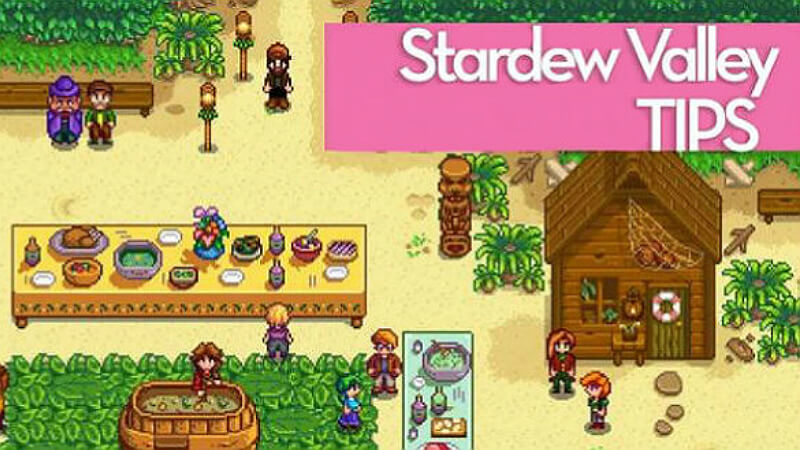
These are suggestions that don’t really fit anywhere else.
Pay attention to your TV. Weather reports are important. Rain in Y1 is basically a license to have some fun. Do some fishing or some mining — you’ve got time.
Birthdays are important. Pay attention to the calendar. Gaining rep with the locals can be a slog until you have access to all the crops and popular gift items like mayonnaise and sashimi. Even if it’s just crap off the ground that the person in question won’t hate you for, give them something on their birthday. Buy a calendar for your house from Robin when you can afford it.
This game encourages hoarding. Chests cost 50 wood and you’ll probably have quite a few by the end of Y1. Early on plant some near your house. As you expand, place chests near places where you deal with harvesting things like the coop/barn or greenhouse or whatever. Also: save some stuff. I know it’s tempting to sell everything in spring Y1, but there are a lot of crops that are excellent gifts. And you never know when somebody wants an item for a quest. Most slow growing veggies like cauliflower and pumpkins will be requested by someone mid-season.
Horse-proof your farm early on. Eventually you’ll have a horse that will let you move around Pelican Town much faster than you would by foot. But it requires a space two squares wide when moving up and down. You’ll quickly discover how much of a nuisance this can be when you try navigating the main town map and parts of the Cindersnap Forest. So make sure as you build your farm to leave some space for the horse for the north and south exits.
You’re starting to feel exhausted… Everything you do drains the energy bar. From watering your crops to fishing to cutting down those pesky trees on your farm, it all takes energy. To counter this, you can eat every other thing you find on the ground. Fish up a bunch of seaweed and jola cans? Eat/drink that crap no matter how unhygienic it might be. Found some spring onions near the sewer entrance in the lake? Eat it! Early on once you have some expendable cash on hand, you can buy salads from the bar for 220g a pop. These will get you by when you need it. Later on, you can turn crap fish into sashimi once you have the kitchen upgrade or turn milk into cheese when you have cows and goats. Gold star milk is arguably the best item in the game for recharging energy.
Whatever you do, do not get into habit of going to sleep early just because you have no energy. Time = money. Or in the case of Stardew Valley, progress.
All trees are fair game. there are no negative effects for chopping down trees outside of your farm. So if you have the energy to spare and your farm is cleaned up, kill it. Or better yet: put a tapper on it. There are quite a few maple and oak trees on the map south from your farm. It’s worth it to put tappers on all of them if you’re building kegs and bee houses. You are going to be in need of MANY oak resin and maple syrup.
Keep your eye on the clock. Each day has a definitive start (6 am) and a definitive end (2 am). After 1 am, you will recover less energy when you sleep. At 2 am, you automatically pass out. Unless you’re rich, don’t make a habit out of this as it sets you back 1000g.
Life tip for sprinklers: Put a floor tile under a sprinkler. You won’t knock it out of place when you use your hoe.
Farming
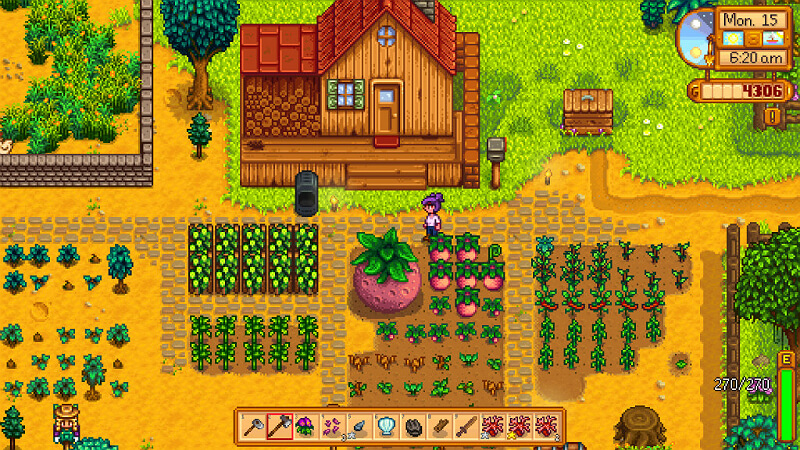
Growing crops will be your main source of income for some time. It’s not the most complex process: you till a spot with your hoe after you reclaim some territory from the sprawling mess on your farm. You plant a seed. You water it once a day for however many days the tooltip on the seeds says. And voila: you harvest a crop. If you want to get fancy, you can throw some fertilizer on the patch before planting your seed. As the game progresses and your farming skill improves, you’ll gain access to a number of specialized fertilizers.
Build in 6×6 squares: this is a matter of taste. I largely suggest this as a means to pre-build for the later addition of sprinklers. Quality sprinklers come into play later in the game and will save the player time and energy. Doing this early on will save time later moving things around on your farm. I suggest something like this.
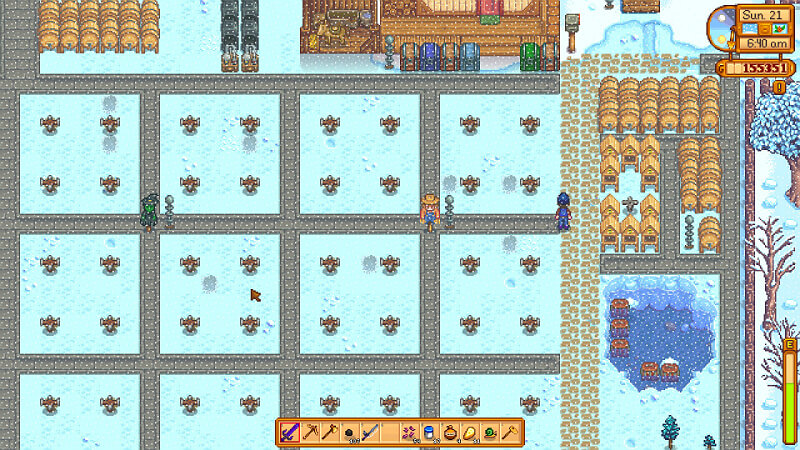
Pay attention to the tooltip on the seeds: Seeds are seasonal. Potatoes only grow in spring. No matter how hard you try, they won’t grow in the summer or fall. So after Spring 28, no more potatoes unless you unlock the greenhouse. There are a couple crops that are multi-seasonal like corn and wheat, but these are the only exceptions. You should also pay attention to how many days it takes for a seed to reach maturity. Cauliflower takes 12 days to mature. Planting a bunch of cauliflower seeds on day 18 of Spring is a bad idea.
Also there are a set of seeds that require what’s called a trellis. This includes green beans, tomatoes, grapes, hops, and whatever crops I might have missed. Essentially this set of crops grow on a stick. You will not be able to move through these crops like with the others.
Scarecrows: Over time, your crops will be threatened by crows. Craft scarecrows to counter this. Keep in mind that scarecrows have a 8 square radius that looks like this. You can also buy or win special ‘rarecrows’ in certain events. These are one-of-a-kind scarecrows that come in many unique appearances. Otherwise, they act like plain scarecrows.
Fishing
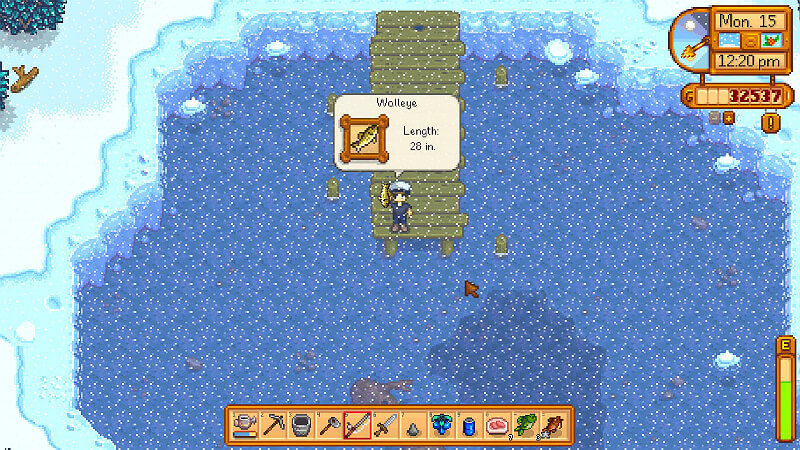
Fishing is one of those things that you either love it or hate it. A lot of this involves the fishing mini-game. At fishing 0, that little green bar is reaaaly small. But as you keep catching fish and leveling up, it gets quite forgiving. At least until you start dealing with some of the more difficult to catch legendary and summer fish like Pikes, Octopus, and so on.
Anyhow, fishing can be very lucrative…. provided you get the hang of the fishing minigame. Your goal is to keep the fish inside the left-side green box while the green meter on the right goes up. If it slips out of the green bar, the progress bar drops. To keep things steady, tap C (keyboard) or X (gamepad) to keep up with the fish. If the fish moves down, stop tapping. Once the progress bar maxes out, the fish is yours. Otherwise if the fish slips out of your green bar, the fish will escape.
The goal is to keep at it. It’s easy to snag the first backpack upgrade in the first week just from fishing in Y1 spring once you get a handle on the minigame. And the money from fishing later can be used to buy salads from the bar to keep your energy up.
Save your junk: Seaweed and algae are cooking ingredients that also double as emergency rations. Trash and driftwood can be recycled into torches and wood. Soggy newspaper has a chance to be recycled into cloth. The items that are really worth saving are broken cds and glasses. These can be recycled into refined quartz for sprinklers.
Mining & Tool Upgrades
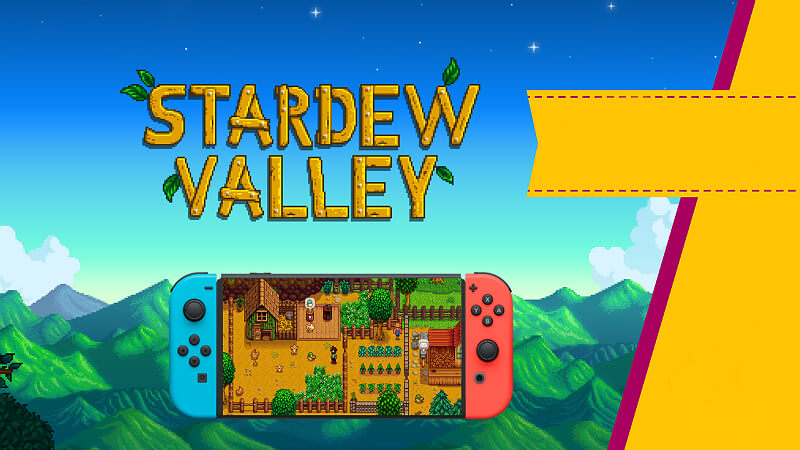
The mine comes into play on the 5th day and offer the player with the opportunity to get ore. Ore is important because it can smelted into ingots. And those ingots are used for all kinds of crafted items as well as tool upgrades. There are also all kinds of items in the mine that you can’t find elsewhere like gems and there are rewards from the adventure guild for killing X amount of Y monster.
But it deserves to be mentioned: progressing through the mines won’t make you rich. But it will make your life much easier. Tool ugprades will save you energy long-term. But the real reason to go spelunking is quality sprinklers. I’ll talk about this more in Summer Y1.
Watch your health: You don’t want to die in the mine. If you do, you’re going to lose money and items. So make sure you have your eye on your health bar. To prevent this from happening, carry some food on you at all times. You’ll also want to keep your energy up. Not going to get far if you can’t mine things with your pickaxe.
Destroy all rocks: Not all the rocks, but you really want to hit any precious gem nodes. These are worth more for mining skillups than plain rocks or ore veins.
Tool upgrade priority: Not all tools are created equally. Some upgrades are more useful than others. But generally it goes like this:
Watering Can > Mining Pick = Axe > Hoe
The first watering can upgrade, in particular, is important for Y1. Holding down C (keyboard) or X (gamepad) allows you do a charged effect that waters crops in a 1×3 column. This lets you water more crops faster. It still costs the same in energy, however. But it will save you time until you have quality sprinklers. The steel upgrade is kinda meh (1×5 column), but the gold watering can is definitely worth the 10,000g price tag (3×3).
However by the time you get the gold upgrade, you should have moved to sprinklers. The mining pick and axe are equally solid upgrades that will save you energy over the long-term. The hoe is kinda… well. It’s handy when you’re cleaning up the farm during season transitions, but that’s about it. And digging up large tracts of the desert and beach in pursuit of artifacts. Its upgrades function exactly like the watering can. Consider upgrading it to gold during winter of Y1 if you have excess money.
Bundles
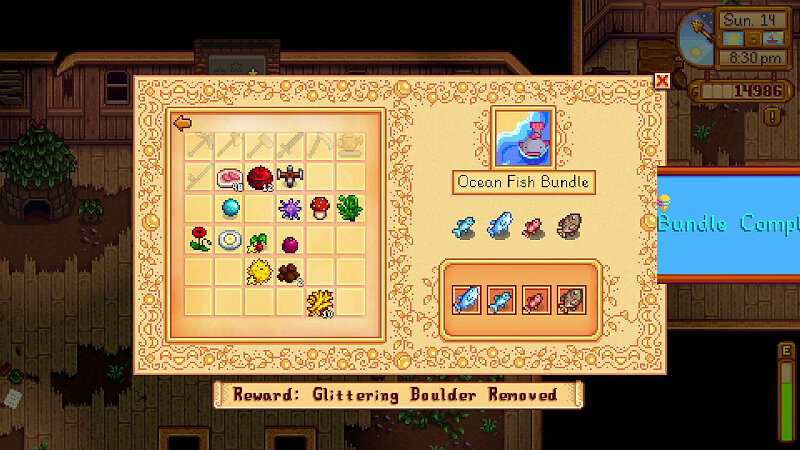
A few days into the game — maybe a week or so — you’ll be treated to a cutscene involving Lewis lamenting the state of the community center. After fulfilling a quest or two, the player will be offered the chance to rebuild the community center. Or be a sell out and help Joja. The Joja route is easier as it requires a straight payout in gold to repair town features, but makes you feel dirty every time to you walk past that warehouse. Restoring the community center is definitely more rewarding (especially the cutscene at the end), but it requires completing bundles.
Bundles are sets of items that you are required to turn in. If you finish a set, you are rewarded with an item or friendship with the locals. Complete the entire set of bundles and the junimos will repair a part of Pelican town. These include the greenhouse on your farm, the mine cart system, the bus to Calico desert, the bridge to quarry, and the boulder in the mountains.
The wiki has more information on bundles. I strongly suggest checking it out and get used to which items are required for which bundles.
Get used to bee-lining for the traveling merchant: Every Friday and Sunday, the traveling merchant will show up near the lake south of your farm. This traveling merchant will be a key companion for completing the bundles in Y1. Every time it shows up, it will carry random items. This includes items out of season that may help fill in the blanks. Of particular interest should be any of the tree fruits like apples, oranges, and apricots.
These fruit trees normally require 28 days to grow and only produce in their season. So an orange tree planted in summer that grows to maturity in fall won’t produce oranges until Summer year two. The downside is that the traveling merchant’s stock is more expensive than other merchants (with some exceptions). If a rabbit’s foot pops up, buy it.
Bundle priorities: Not all bundles and bundle rewards are created equally. This is subject to debate, but the priority I suggest is: greenhouse > mining carts > bulletin board > fish tank = bus. The greenhouse is extremely useful for Winter Y1 if you can fulfill the items for the bundles. You can plant any seed regardless of the season inside. The mining carts will make moving around the town far easier.
The bulletin board is by far the trickiest bundle set to finish (red cabbage is a Y2 summer crop), but completing it will earn you tons of reputation with the locals. The fish tank and bus bundles you can finish at your leisure. The fish tank has some good individual bundle rewards, but the end result (panning) is functionally worthless. And the bus isn’t worth it until you have the Skull Key from level 120 of the mine.
Spring Y1

Priorities for Spring Y1:
- Save 10,000g for Summer
- Buy the 1000g backpack upgrade
- Collect 300 wood to fix the beach bridge
- Get to level 40 in the mine
- Buy at least 1 pack of strawberry seeds from the egghunt event on Spring 13.
Ah that new farmer smell… Your options in spring of Y1 are extremely limited thanks to being broke and having no options for energy regeneration. Spend your starting cash on 8 green bean seeds and spend the rest on parsnips. Farm in 6×6 squares — this will alow you to easily switch later on to sprinklers. Green beans are trellis seeds so make sure you leave the center empty. Green beans are a crop that regrows every couple days, but require being planted early to get the maximum payout. Early on, try to grow enough crops that it requires half of your energy to water.
Otherwise spend your time hunting for food, fishing once you have the fishing rod, or clearing out your farm. Ignore the grass, but feel free to kill any bushes with your scythe. Once you have 300 wood, fix the bridge at the beach. The coral on the east part of the beach can fetch a pretty penny. Definitely make it a point to check the beach on rainy days as more coral may spawn.
As far as farming goes, mix it up. Your priorities should be potatoes, cauliflower, and parsnips, but you’ll probably want to grow a bit of everything. If you have cash to spare, keep your eyes on the traveling merchant on Fridays & Sundays. Use any sap you get from trees for fertilizer — you want those gold star crops for bundles. Try to fill as many bundles as you can. Missing anything from spring could require having to put off the greenhouse until Y2.
After day 5, you have access to the mines. Go there sparingly as energy and money allows. Try to make it a priority to get to level 40 as soon as possible during spring. Floors 40+ offer iron. If you can push it higher, that’s even better. If not, oh well: the mine isn’t going anywhere. But 40 is a good floor to shoot for. You should have enough time in one day (post watering crops) to progress at least 5 floors a day. 10 floors isn’t impossible (if you have cash for salads), but you’re pushing your luck. The ultimate goal is to get to floors 80+ as that’s when gold ore starts popping up.
The most important priority is to save 10,000 gold for Summer. Summer is going to be where you really start bringing in the cash from farming so you need money for seeds. If you can spare it, consider buying the summer tree seeds and plant them before the end of spring. You won’t get many fruit out of it, but at least you’ll fulfill the requirements for bundles.
Try to buy at least one pack of strawberry seeds at the Egghunt event. Once you have the greenhouse, you can use that strawberry seed to grow strawberries outside of spring. And by the then once you have the seed maker later on, you can turn those strawberries into a crapton of seeds for Spring Y2. Or buy one or more seeds and save the strawberries for later.
Summer Y1
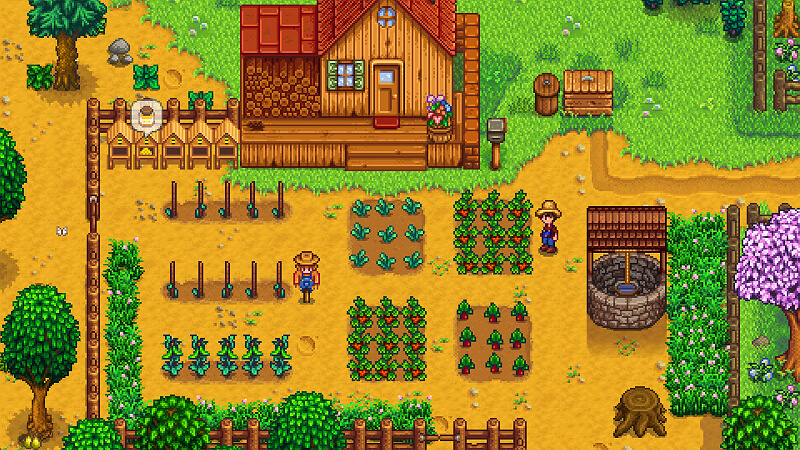
Priorities for Summer Y1:
- Save money for fall.
- Buy the 10,000g backpack upgrade
- Reach level 80+ in the mine & fix the mining carts
- Upgrade the Mining Pick & axe to steel
- Clean up your farm
- Build some quality sprinklers
- Build a silo
- Upgrade your house
- Plant a rare seed before Fall 1.
Oh summer: it’s time to make some money! Remember that 10,000g you saved up? Spend at least half if not more of your seed money (pun intended) on blueberry seeds on day one. This is the main money maker crop for summer. They work just like green beans: every couple days after they mature, you’ll get a fresh harvest. The exception here is that you’ll get 3 blueberries per harvest.
Multiply that over 100+ seeds and you can guess where this is going. The downside is that blueberries take 13 days to mature. Which means you’ll be waiting awhile for the payoff. You’ll also be burning most if not all your energy on watering crops. In summer, you’ll gain access to the spa in the mountains to the north of Robin & Demetrius’ house. This is a cheap way to recharge your energy, but it’s also time consuming.
Don’t neglect other summer crops. You’ll need some gold star melons and will want to plant at least a couple corn, tomato, and hot pepper crops. And consider planting some hops and wheat. Hops are great once you have some kegs. Wheat can be saved for when you get a mill. It’s super cheap (10g each) and grows to maturity in 4 days.
Alternating fishing and mining will tide you over until harvest time. Fishing can be tricky at this time of the year. Pikes (town/lake) are a pain to catch, but somewhat profitable. Pufferfish and super cucumber (beach) are equally annoying. If you want to test your luck, the first legendary fish that most normal players can actually catch is available off the west-side pier of the beach. Good luck.
As far as mining, your goal for summer is to reach level 80+. Once you have gold ingots, you can start building quality sprinklers. These are literally game-changers. No longer will you have to spend so much time and energy watering your crops every day. Regular sprinklers are barely worth building. Quality sprinklers, however, are. They water all adjacent tiles so they hit a 3×3 square.
They require 1 iron ingot, 1 gold ingot, and 1 refined quartz. The ingots are obvious. Refined quartz comes from 2 sources. You can throw a quartz and coal into a furnace to get a refined quartz. Or you can chuck all the broken cd and glasses you get from fishing into a recycling machine (crafted. Recipe is earned at level 4 fishing). Make as many as you can. Ghosts in the mines can also drop refined quartz, but they are somewhat rare.
Aside from fishing and mining, there’s the matter of the mess on your farm. Clearing the trees is a must. Not only because you long-term need the wood, but because you need the foraging skill ups. At level 6 foraging, you get he recipe for crafting lightning rods. Thunder storms are a common nuisance during summer and pop up occasionally during fall. Not only do they protect your crops, they’re also a steady source of batteries. You’ll need these for later crafting recipes.
Generally, I use the right side of my farm for crops. The upper left-side is where I put the barn & the coop. The lower left corner I use as an expendable tree farm using seeds dropped from chopping trees. Also consider a maple/oak tapper farm somewhere on your farm. You’re going to need a lot of oak resin and maple syrup later on so start on that early. Or just do your own thing.
Once the blueberries are ripe for harvest, you will have a lot of options as far as where to spend that sweet sweet cash. If you have the ingots to spare, upgrading your pick and axe to steel are worth considering. You need steel level tools to clear some of the remaining trash on your farm as well as gain access to the secret forest found to west of the Cindersnap Forest.
There’s also your house. The first upgrade comes with a kitchen. If you’ve been making friends, you’ll have access to some recipes. If you’ve been giving Linus stuff, he rewards you with the sashimi recipe at 3 hearts. This lets you convert any fish into a food that gives 75 energy and 30 health. Turn all the crap fish like anchovies and carp into something useful. Also works well with many less useful crab pot ‘fish’ like periwinkles. Also: a lot of the locals like sashimi. This solves any energy problems you’ll ever have.
Distantly, there’s the barn and coop. Farm animals require some investment before they become useful so you might want to put it off. The coop includes chickens as well as ducks and rabbits later on. Eggs are useful for mayonnaise — a gift that many of the locals like with a handful of a exceptions. Mayonnaise and Duck mayonnaise are two different items. Ducks produce feathers (a bundle item) and rabbits produce wool and very very rarely a rabbit’s foot. Barns cover cows and later on goats, sheep, and pigs. Cows and goats produce milk. Sheep can be sheered for wool. Pigs dig up truffles. Make sure to build a silo to store hay first.
Otherwise, focus on clearing bundles where you can. If you’re past level 80 in the mine, you shouldn’t have much trouble clearing the bundle set for repairing the mine carts. This lets you easily get around town and to the mines saving you a ton of time. Clear out the secret woods for hardwood when you have time to spare. If you have the materials to spare, start building some kegs and beehouses. Kegs are used to make wine and other kinds of beverages. Beehouses produce honey from nearby flowers. Both are solid money makers and worth the investment.
Save some non-star blueberries and possibly melons for kegs later. If you have a ton of cash, consider buying & planting the fall fruit trees early on for bundles. Also buy & plant a rare seed before Fall 1. The rare seed grows into a sweet gem. You can give this to the statue in the secret woods for a stardrop.
Fall Y1
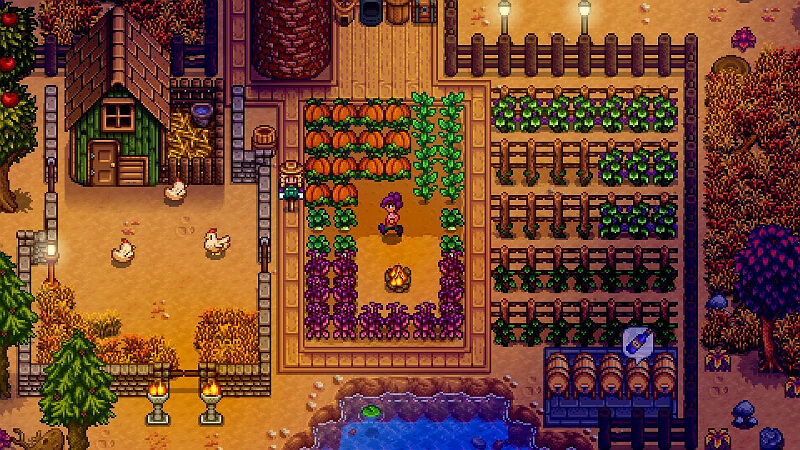
Priorities for Fall Y1:
- Plant a crapton of cranberry seeds
- Keep mining for materials where necessary
- Consider buying a coop/barn
- Start gifting to the locals
- Get the stardrop from the fair
- Build the stable
Fall. Pending on your progress, you can start chilling out to a degree. If you haven’t converted to sprinklers, you should be able to get there in fall. If you have items they like, start aggressively gifting items to the locals. Your primary goal in this season is going to clearing as many bundles you can. You’ll also want to plant a crapton of cranberries. These work exactly like blueberries and the payoff is better. Save some for kegging later.
If you put off building the coop or barn, now is a good time to build them. Everybody loves mayo. And if they don’t, give them sashimi. Turn milk into cheese and you’ll have the easiest to make energy/health item. Make sure to build a silo (or two — the costs are trivial at this point). Make it a point to have a full silo for winter. And buy heaters for the coop and the barn. If you can spare the price of the upgrades, get the deluxe barn & coop. You need cow & goat milk, chicken & duck eggs, and wool for the animal bundle (Greenhouse).
If you haven’t already, go all out on beehouses and kegs. You put tappers on all the oaks & maples around the Cindersnap Forest entrance to the sewer right? Beehouses are super lucrative during fall thanks to fairy roses. And kegs are forever. Kegs will single-handedly get you through winter provided you build enough of them. Consider building a shed if you have the cash to spare for it. If you need material, Robin sells wood for 10g each. Clint sells all the ores and coal.
If you haven’t already done so, build a stable. The horse makes moving around town much easier even the game seems to hate the horse.
Winter Y1
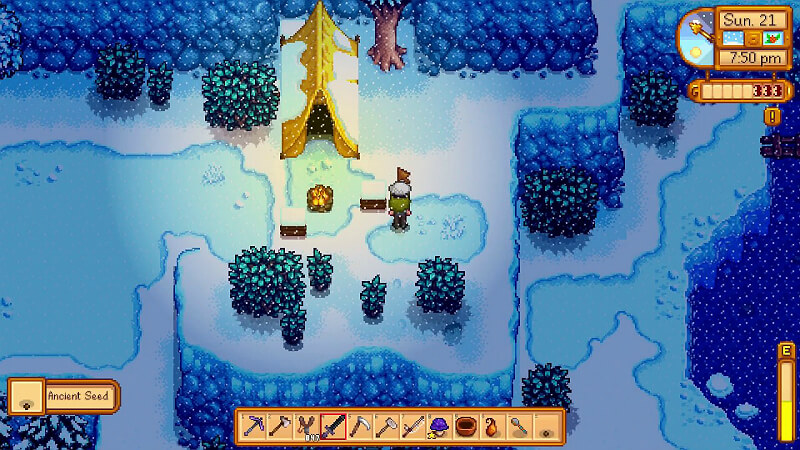
Priorities for Winter Y1:
- Build (more) kegs
- Pet all the critters
- upgrade all your tools to gold
- Clear adventurer guild slayer objectives
- start poking around the Skull Cavern
- scrounge for worms & artifacts
Winter. Aside from winter seeds, there’s no farming to be done. This is supposed to be the breather season. Time to focus on mining, fishing, petting your critters, and kegging all the things. Oh and stalking the traveling merchant for the out-of-season bundle items that haven’t popped up yet. Pray to RNGesus for a rabbit’s foot. Keep giving people things that make them happy. If you really want to push it, aim for a waifu or husbando. You have 28 days to do whatever you feel like.
If you won the lotto and got all the items for the greenhouse, now is a good time to get started on that. If the RNG gods are gracious and you stumbled across an ancient seed, now is a good time to plant it in the greenhouse. Put the best speed gro fertilzer you have access to underneath and let it grow. And every time you get an ancient fruit once a week, chuck the fruit into a seed maker. Repeat and repeat until you have ancient fruit seeds for days. And once you’re set, chuck the fruits of your labor into kegs & profit.
There’s still the slayer objectives for the adventure guild. You probably should get on those. With the exception of slimes, the monsters are all exclusive to the mine.
If you’re bored of farming the mine and want a bigger challenge, there’s the Skull Cavern in the Calico Desert. Be prepared because everything hits harder in the cavern. Come prepared. Bombs, cheese for healing, stone for emergency stairs, etc. etc. As you go further down, you’ll see more iridium ore veins. And if you find a prismatic shard, lug it over to the pedestal outside the cavern entrance. Congratulations on getting the best sword in the game. Do not under any circumstances give your first prismatic shard to Gunther at the museum. Don’t do that. Just don’t. You never know when you’ll see another shard.
Another thing to consider is worm hunting. In winter, it’s much easier to spot the bastards. Artifacts are rare, but this is the best time of year to go hunting for them.
Year 2
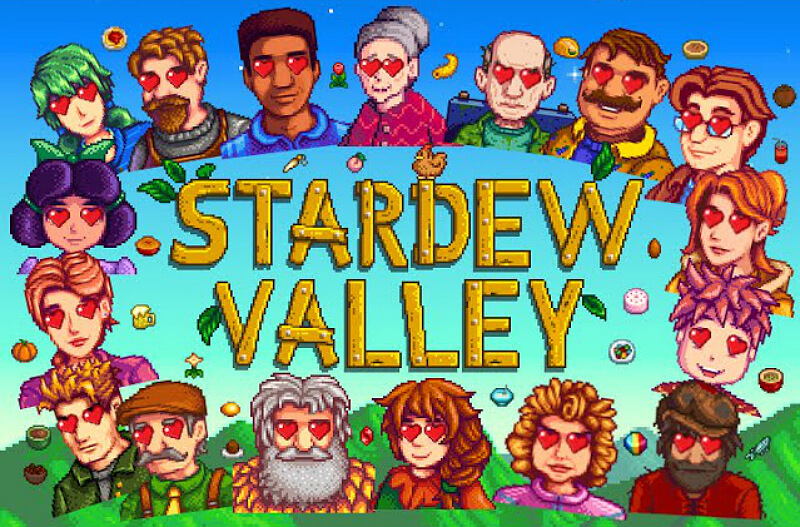
Spring of year 2 isn’t much different than spring of year one. Pierre offers a new seed type for each season and Kent (Jodie’s husband) returns from the war. Do all the things you haven’t already done. If it starts raining, make it a point to bee-line for the mountains. The Legend can be caught in the mountains. Unless you’re some kind of god at the fishing game, you probably didn’t catch the legend in Spring Y1. It’s also worth noting the Legend is worth a crapton of money. And you can catch more than one (on the same day you caught it).
Original Link – Continuation of discussion


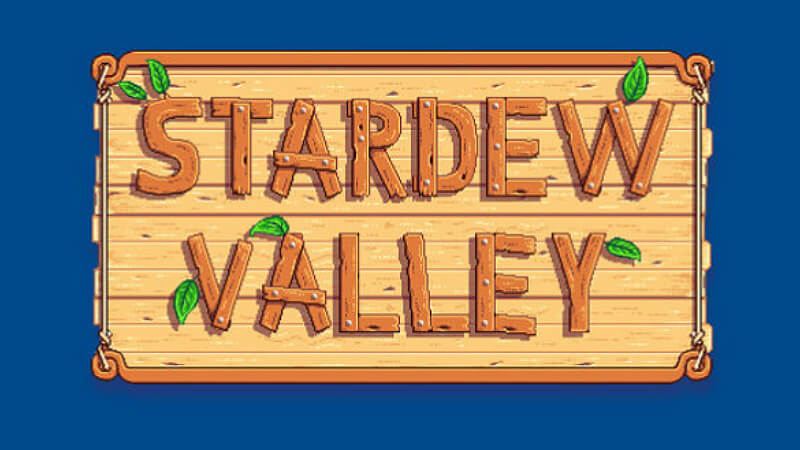
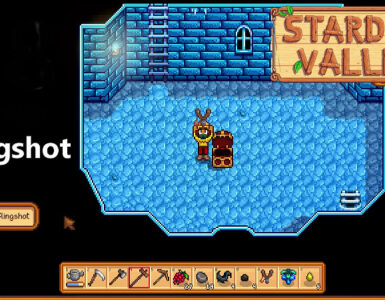
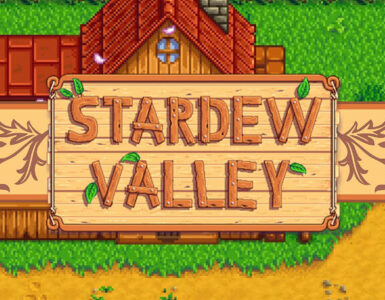
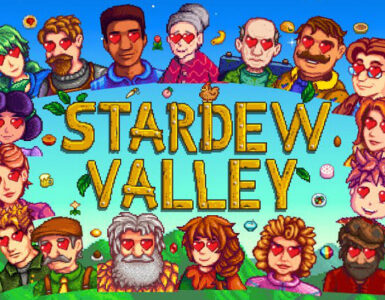
Add comment